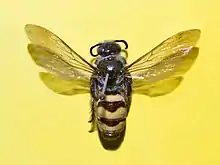| Dielis trifasciata | |
|---|---|
 | |
| Dielis trifasciata. Museum specimen | |
| Scientific classification | |
| Domain: | Eukaryota |
| Kingdom: | Animalia |
| Phylum: | Arthropoda |
| Class: | Insecta |
| Order: | Hymenoptera |
| Family: | Scoliidae |
| Genus: | Dielis |
| Species: | D. trifasciata |
| Binomial name | |
| Dielis trifasciata (Fabricius, 1793) | |
| Synonyms[1][2][3] | |
| |
Dielis trifasciata, also known as the three-banded scoliid wasp, is a species in the family Scoliidae.[3]
Description and identification
Dielis trifasciata typically have a body length of 10–15 millimetres (0.39–0.59 in),[4] though males of the subspecies D. t. nassauensis can reach up to 19 millimetres (0.75 in).[5] The females have yellow bands on the three anterior abdominal segments.[6] These bands are broad in the nominate subspecies, D. t. trifasciata but very narrow in the subspecies D. t. nassauensis. In males, the last three abdominal segments are black, and the scutellum has a single yellow band. The males of D. t. trifasciata are distinguished from allied species in part by the extensively yellow clypeus.[1]
Biology
These parasitic wasps lay eggs on larvae of the scarab Phyllophaga portoricensis.[4] Adult scoliids feed on nectar and possibly pollen.[7]
Distribution
Dielis trifasciata is present in southern Florida, the Bahamas, and in most of the Greater Antilles.[4][1]
Subspecies
There are two subspecies of D. trifasciata:[8]
- Dielis trifasciata nassauensis (Bradley, 1928)
- Dielis trifasciata trifasciata (Fabricius, 1793)
Gallery
.jpg.webp) D. trifasciata nassauensis female in the Bahamas.
D. trifasciata nassauensis female in the Bahamas..jpg.webp) D. trifasciata nassauensis male in the Bahamas.
D. trifasciata nassauensis male in the Bahamas. D. trifasciata trifasciata female in Florida.
D. trifasciata trifasciata female in Florida..jpg.webp) D. trifasciata trifasciata male in Cuba.
D. trifasciata trifasciata male in Cuba.
References
- 1 2 3 Bradley, James Chester (1928). "The Species of Campsomeris (Hymenoptera-Scoliidae) of the plumipes Group, Inhabiting the United States, the Greater Antilles, and the Bahama Islands". Proceedings of the Academy of Natural Sciences of Philadelphia. 80: 313–337. Retrieved 2023-07-17.
- ↑ Krombein, Karl V. (1979). "Scoliidae". In Krombein, Karl V.; Hurd, Paul D. Jr.; Smith, David R.; Burks, B.D. (eds.). Catalog of Hymenoptera in America North of Mexico. Vol. 2. Apocrita (Aculeata). Washington, D.C.: Smithsonian Institution Press. p. 1316.
- 1 2 Holm, Heather (2021). "Chapter 10 Scoliidae: Scoliid Wasps". Wasps: Their Biology, Diversity, and Role as Beneficial Insects and Pollinators of Native Plants. Minnetonka, MN: Pollination Press LLC. p. 214–229. ISBN 9780991356317.
- 1 2 3 Grissell, Eric E. (2007). "Scoliid Wasps of Florida, Campsomeris, Scolia and Trielis spp. (Insecta: Hymenoptera: Scoliidae)" (PDF). Featured Creatures, DPI Entomology Circulars 179 and 185. University of Florida Entomology and Nematology Department, UF/IFAS Extension. Retrieved 30 October 2015.
- ↑ Krombein, Karl V. (1953). "The Wasps and Bees of the Bimini Island Group, Bahamas, British West Indies (Hymenoptera: Aculeata)" (PDF). American Museum Novitates (1633): 1–29. Archived from the original (PDF) on 4 March 2016. Retrieved 30 October 2015.
- ↑ Wolcott, George N. (1948). "Insects of Puerto Rico" (PDF). Journal of Agriculture of the University of Puerto Rico. 32 (4): 855. Retrieved 30 October 2015.
- ↑ Khouri, Z.; Gillung, J.P.; Kimsey, L.S. (2022). "The evolutionary history of mammoth wasps (Hymenoptera: Scoliidae)". bioRxiv 10.1101/2022.01.24.474473.
- ↑ Osten, T. (2005). "Checkliste der Dolchwespen der Welt (Insecta: Hymenoptera, Scoliidae). Teil 1: Proscoliinae und Scoliinae: Campsomerini. Teil 2: Scoliinae: Scoliini. Teil 3: Literatur" [Checklist of the Scoliidae of the World. Part 1: Proscoliinae and Scoliinae: Campsomerini. Part 2: Scoliinae: Scoliini. Part 3: Literature] (PDF). Bericht der Naturforschenden Gesellschaft Augsburg (in German). 62 (220–221): 1–62. Retrieved 2023-07-17.